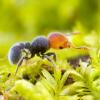How do army ants raise their colonies and brood? this was a question for me because they're always moving. another question is how do the queens found colonies? thanks for all input!
- Formiculture.com
- Forums
- Gallery
- Members
- Member Map
- Chat

How do army ants raise their colonies and brood? this was a question for me because they're always moving. another question is how do the queens found colonies? thanks for all input!
Ants I am keeping:
none for now, planning on being more active this year
How do army ants raise their colonies and brood? this was a question for me because they're always moving. another question is how do the queens found colonies? thanks for all input!
They go through stationary phases- where they raise their brood and raid ant nests and kill anything that moves- and nomadic phases where the bivoac dissolves and the colony creates a new one somewhere across their home range.
Queens don't found colonies. The parent colony will produce 3-5 virgin queens and a few dozen males in late summer here in the Southeastern US, and the virgin queens each take a portion of the colony (a few thousand, usually) and head out on their own to establish a new home range and bivoac. Males from neighboring colonies will seek out freshly budded colonies and make their way over to the bivoac. The workers (if deemed worthy) will lead him to the queen where he fertilizes her for the rest of her life. The colony will then eat the male after he dies of exhaustion.
My Main Journal | My Neivamyrmex Journal | My Ant Adoption | My YouTube
Join the TennesseeAnts Discord Server! https://discord.gg/JbKwPgs
0 members, 0 guests, 0 anonymous users